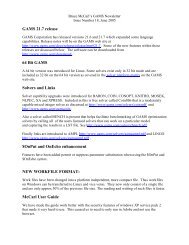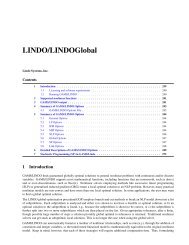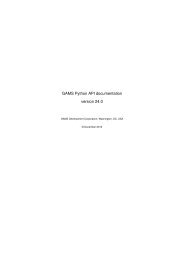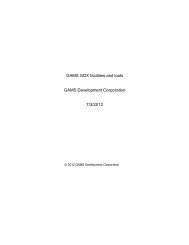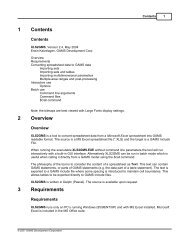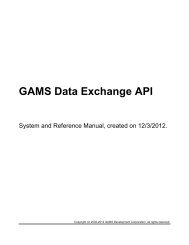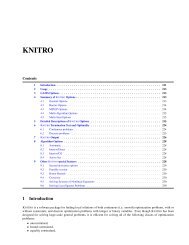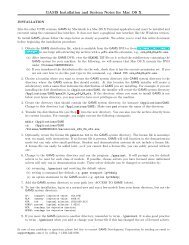Economic Equilibrium Modeling with GAMS
Economic Equilibrium Modeling with GAMS
Economic Equilibrium Modeling with GAMS
You also want an ePaper? Increase the reach of your titles
YUMPU automatically turns print PDFs into web optimized ePapers that Google loves.
8<br />
A MPSGE model speci cation is always listed between $ONTEXT and $OFFTEXT statements.<br />
The rst statement <strong>with</strong>in an MPSGE model-description assigns a name to the<br />
model. The model name must begin <strong>with</strong> a letter and must have 10 or fewer characters.<br />
$ONTEXT<br />
$MODEL:DEMAND<br />
The model speci cation begins by declaring variables for the model. In a standard<br />
model, there are three types of variables: commodity prices, sectoral activity levels, and<br />
consumer incomes. The end of each line may conclude <strong>with</strong> a \!", followed by a variable<br />
description.<br />
N.B. The variables associated <strong>with</strong> commodities are prices, not quantities. (In this and<br />
subsequent models, I use P as the rst letter for each of the commodity variables to remind<br />
us that these variables are prices.)<br />
N.B. The variable associated <strong>with</strong> a consumer is an income level,notawelfare index.<br />
$SECTORS:<br />
X ! ACTIVITY LEVEL FOR X = DEMAND FOR GOOD X<br />
Y ! ACTIVITY LEVEL FOR Y = DEMAND FOR GOOD Y<br />
$COMMODITIES:<br />
PX ! PRICE OF X WHICH WILL EQUAL PL<br />
PY ! PRICE OF Y WHICH WILL EQUAL 2 PL<br />
PL ! PRICE OF THE ARTIFICIAL FACTOR L<br />
$CONSUMERS:<br />
RA ! REPRESENTATIVE AGENT INCOME<br />
Function speci cations follow the variable declarations. In this model, our rst declarations<br />
correspond to the two production sectors. In this model, the production structures<br />
are particularly simple. Each of the sectors has one input and one output. In the MPSGE<br />
syntax, I: denotes an input and O: denotes an output. The output quantity coe cients<br />
for both sectors are unity (Q:1). This means that the level values for x and y equal the<br />
quantities produced.<br />
The nal function speci ed in the model represents the utility function and endowments<br />
for the single consumer. In this function, the E: entries correspond to endowments and the<br />
D: entries are demands. Reference demands, reference prices and the substitution elasticity<br />
(s:1) characterize preferences.<br />
The demand entries shown here are consistent <strong>with</strong> a Cobb-Douglas utility function in<br />
which the budget share for y is twice the budget share for x (i.e. the MRS at (1,1) equals<br />
1/2):<br />
$PROD:X



